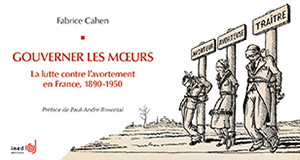Governing mores: the battle against abortion, 1890-1950

From the 1930s to the 1950s, under the influence of an extremely powerful anti-abortion crusade, the French authorities believed—or wanted to believe—that they could put an end to abortion. In Gouverner les moeurs: la lutte contre l’avortement en France, 1890-1950 [Governing mores: the battle against abortion, 1890-1950], Fabrice Cahen draws on a considerable body of historical material to analyse a long-term experiment that ranged from prohibition and occasional sanctions in the nineteenth century to a systematic, voluntary policy in the first half of the twentieth. It is a well-known fact in France that the Vichy government used the guillotine twice against abortionists. Cahen brings to light additional realities, including an average of ten criminal convictions per day in the 1940s; the existence of special police services to track down the practice in Paris and some départements; and the Paris examining magistate who, at the start of the Fourth Republic, engaged in a personal campaign against doctors suspected of performing abortions, exchanging information directly with the Order of Physicians.

The book explains how women wishing to end their pregnancy (and third parties assisting them or involved in carrying out the practice) managed to circumvent the laws, using objects and substances not meant for the purpose and diverse subterfuges to dodge the authorities. But it goes much further, presenting a case study that clarifies how an accumulation of prohibitions can stimulate the imaginations of offenders, leading to the establishment of informal networks and ultimately the development of full-fledged businesses.
One particularity of the battle against abortion in France was the authorities’ dependence on rumour and denunciations. The anti-abortion crusade conducted in the middle third of the twentieth century generated intense mutual surveillance and informing. This was how the judicial authorities increased their activity figures, destroying good community relations in villages and neighbourhoods and trust between women and their doctors. Overall, physicians remained loyal to their professional principles, continuing to care for all patients, including women suffering from infections or complications due to a practice they may have disapproved of. However, a considerable number did not hesitate to stigmatize, mistreat and even brutalize these female patients, or to prevent women who suspected they might be pregnant from learning in time that they were so. At a moment when some analysts were including abortion in the category of birth control practices—leaving it to metaphysics to define it otherwise—activists and a segment of the medical profession were working to keep the practice inaccessible, shameful and indeed traumatic.
Source: Fabrice Cahen, 2016, Gouverner les mœurs. La lutte contre l’avortement en France, 1890-1950, Ined, Collection : Études et enquêtes historiques
Contact: Fabrice Cahen
Online: January 2017
